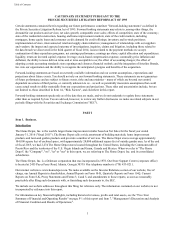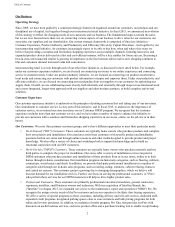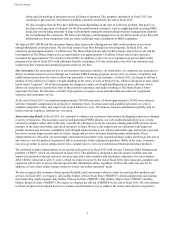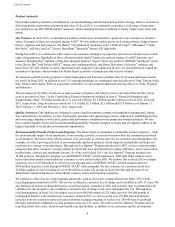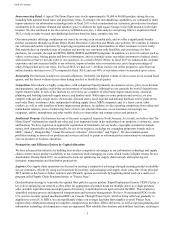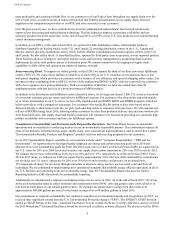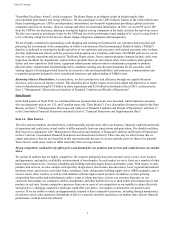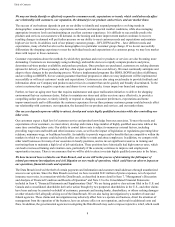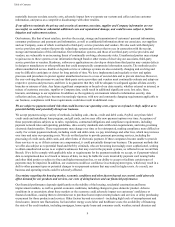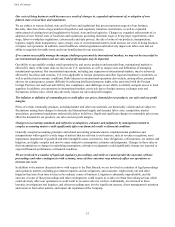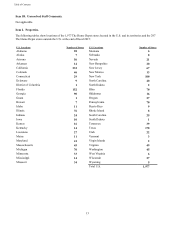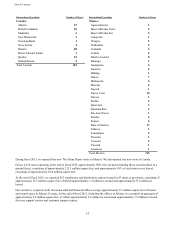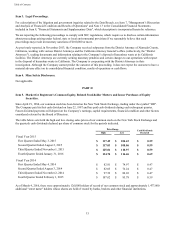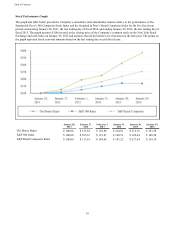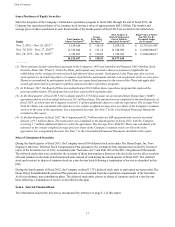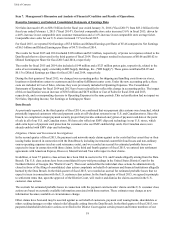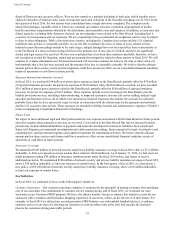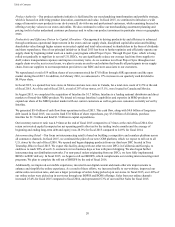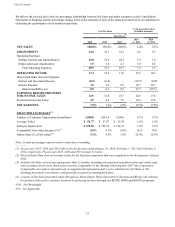Home Depot 2015 Annual Report Download - page 13
Download and view the complete annual report
Please find page 13 of the 2015 Home Depot annual report below. You can navigate through the pages in the report by either clicking on the pages listed below, or by using the keyword search tool below to find specific information within the annual report.Table of Contents
11
provide high-quality service to our customers, while simplifying customer interaction and providing our customers with a
more interconnected retail experience. The cost and potential problems and interruptions associated with the implementation
of these initiatives, including those associated with managing third-party service providers and employing new web-based
tools and services, could disrupt or reduce the efficiency of our operations in the near term and lead to product availability
issues. In addition, our improved supply chain and new or upgraded technology might not provide the anticipated benefits, it
might take longer than expected to realize the anticipated benefits, or the initiatives might fail altogether, each of which could
adversely impact our competitive position and our financial condition, results of operations or cash flows.
If we are unable to effectively manage and expand our alliances and relationships with selected suppliers of both brand
name and proprietary products, we may be unable to effectively execute our strategy to differentiate ourselves from our
competitors.
As part of our focus on product differentiation, we have formed strategic alliances and exclusive relationships with selected
suppliers to market products under a variety of well-recognized brand names. We have also developed relationships with
selected suppliers to allow us to market proprietary products that are comparable to national brands. Our proprietary products
differentiate us from other retailers, generally carry higher margins than national brand products, and represent a growing
portion of our business. If we are unable to manage and expand these alliances and relationships or identify alternative
sources for comparable brand name and proprietary products, we may not be able to effectively execute product
differentiation, which may impact our sales and gross margin results.
Our proprietary products subject us to certain increased risks.
As we expand our proprietary product offerings, we may become subject to increased risks due to our greater role in the
design, manufacture, marketing and sale of those products. The risks include greater responsibility to administer and comply
with applicable regulatory requirements, increased potential product liability and product recall exposure and increased
potential reputational risks related to the responsible sourcing of those products. To effectively execute on our product
differentiation strategy, we must also be able to successfully protect our proprietary rights and successfully navigate and
avoid claims related to the proprietary rights of third parties. In addition, an increase in sales of our proprietary products may
adversely affect sales of our vendors’ products, which, in turn, could adversely affect our relationships with certain of our
vendors. Any failure to appropriately address some or all of these risks could damage our reputation and have an adverse
effect on our business, results of operations and financial condition.
We may be unsuccessful in implementing our growth strategy, which includes the integration of Interline to expand our
business with professional customers and in the MRO market, which could have an adverse impact on our financial
condition and results of operation.
In fiscal 2015, we completed the acquisition of Interline, which we believe will enhance our ability to serve our professional
customers and increase our share of the MRO market. Our goal is to serve all of our different Pro customer groups through
one integrated approach to drive growth and capture market share in the retail, services and MRO markets, and this strategy
depends, in part, on the successful integration of Interline. As with any acquisition, we need to successfully integrate the
target company’s products, services, associates and systems into our business operations. Integration can be a complex and
time-consuming process, and if the integration is not fully successful or is delayed for a material period of time, we may not
achieve the anticipated synergies or benefits of the acquisition. An inability to realize the full extent of the anticipated
synergies or benefits of the Interline acquisition could have an adverse effect on our financial condition or results of
operation. Furthermore, even if Interline is successfully integrated, the acquisition may fail to further our business strategy as
anticipated, expose us to increased competition or challenges with respect to our products or services, and expose us to
additional liabilities associated with the Interline business.
If we are unable to manage effectively our installation service business, we could suffer lost sales and be subject to fines,
lawsuits and reputational damage.
We act as a general contractor to provide installation services to our DIFM customers through third-party installers. As such,
we are subject to regulatory requirements and risks applicable to general contractors, which include management of licensing,
permitting and quality of our third-party installers. We have established processes and procedures that provide protections
beyond those required by law to manage these requirements and ensure customer satisfaction with the services provided by
our third-party installers. If we fail to manage these processes effectively or to provide proper oversight of these services, we
could suffer lost sales, fines and lawsuits, as well as damage to our reputation, which could adversely affect our business.


